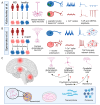Deciphering the Pathophysiological Mechanisms Underpinning Myoclonus Dystonia Using Pluripotent Stem Cell-Derived Cellular Models
- PMID: 39329704
- PMCID: PMC11430605
- DOI: 10.3390/cells13181520
Deciphering the Pathophysiological Mechanisms Underpinning Myoclonus Dystonia Using Pluripotent Stem Cell-Derived Cellular Models
Abstract
Dystonia is a movement disorder with an estimated prevalence of 1.2% and is characterised by involuntary muscle contractions leading to abnormal postures and pain. Only symptomatic treatments are available with no disease-modifying or curative therapy, in large part due to the limited understanding of the underlying pathophysiology. However, the inherited monogenic forms of dystonia provide an opportunity for the development of disease models to examine these mechanisms. Myoclonus Dystonia, caused by SGCE mutations encoding the ε-sarcoglycan protein, represents one of now >50 monogenic forms. Previous research has implicated the involvement of the basal ganglia-cerebello-thalamo-cortical circuit in dystonia pathogenesis, but further work is needed to understand the specific molecular and cellular mechanisms. Pluripotent stem cell technology enables a patient-derived disease modelling platform harbouring disease-causing mutations. In this review, we discuss the current understanding of the aetiology of Myoclonus Dystonia, recent advances in producing distinct neuronal types from pluripotent stem cells, and their application in modelling Myoclonus Dystonia in vitro. Future research employing pluripotent stem cell-derived cellular models is crucial to elucidate how distinct neuronal types may contribute to dystonia and how disruption to neuronal function can give rise to dystonic disorders.
Keywords: Myoclonus Dystonia; SGCE; disease modelling; dystonia; epsilon-sarcoglycan; pathogenesis; pluripotent stem cell.
Conflict of interest statement
The authors declare no conflicts of interest.
Figures





Similar articles
-
Cortical neuronal hyperexcitability and synaptic changes in SGCE mutation-positive myoclonus dystonia.Brain. 2023 Apr 19;146(4):1523-1541. doi: 10.1093/brain/awac365. Brain. 2023. PMID: 36204995 Free PMC article.
-
Twenty years on: Myoclonus-dystonia and ε-sarcoglycan - neurodevelopment, channel, and signaling dysfunction.Mov Disord. 2019 Nov;34(11):1588-1601. doi: 10.1002/mds.27822. Epub 2019 Aug 26. Mov Disord. 2019. PMID: 31449710 Review.
-
SGCE missense mutations that cause myoclonus-dystonia syndrome impair epsilon-sarcoglycan trafficking to the plasma membrane: modulation by ubiquitination and torsinA.Hum Mol Genet. 2007 Feb 1;16(3):327-42. doi: 10.1093/hmg/ddl472. Epub 2007 Jan 2. Hum Mol Genet. 2007. PMID: 17200151
-
Abnormal nuclear envelopes in the striatum and motor deficits in DYT11 myoclonus-dystonia mouse models.Hum Mol Genet. 2012 Feb 15;21(4):916-25. doi: 10.1093/hmg/ddr528. Epub 2011 Nov 11. Hum Mol Genet. 2012. PMID: 22080833 Free PMC article.
-
ε-Sarcoglycan: Unraveling the Myoclonus-Dystonia Gene.Mol Neurobiol. 2021 Aug;58(8):3938-3952. doi: 10.1007/s12035-021-02391-0. Epub 2021 Apr 22. Mol Neurobiol. 2021. PMID: 33886091 Review.
References
-
- Peall K.J., Kurian M.A., Wardle M., Waite A.J., Hedderly T., Lin J.P., Smith M., Whone A., Pall H., White C., et al. SGCE and myoclonus dystonia: Motor characteristics, diagnostic criteria and clinical predictors of genotype. J. Neurol. 2014;261:2296–2304. doi: 10.1007/s00415-014-7488-3. - DOI - PMC - PubMed
Publication types
MeSH terms
Substances
Supplementary concepts
Grants and funding
LinkOut - more resources
Full Text Sources

